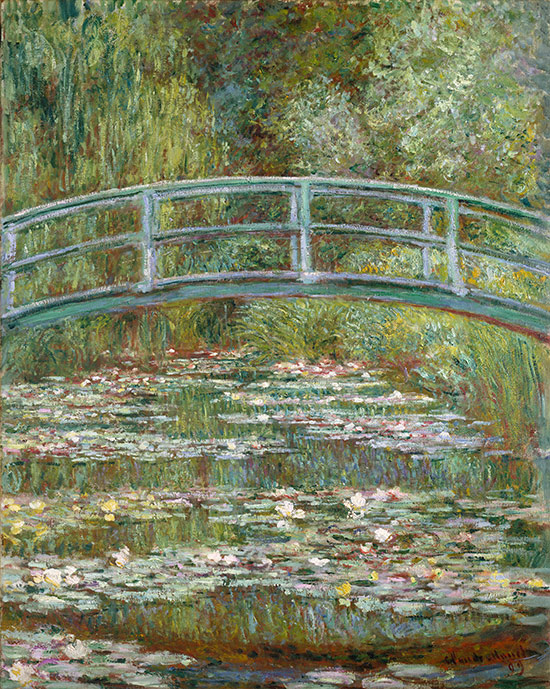A bridge over a pool of water lilies is both serene and beautiful. It’s the perfect place to take a break from your busy day and enjoy nature. The gentle sound of the water flowing beneath the bridge, and the fragrant smell of the lilies, are sure to relax you.
There’s something so tranquil and serene about water lilies. They always seem to be in a world of their own, floating gracefully on the surface of the water. I love to imagine what it would be like to sit on a bridge over a pool of water lilies, surrounded by their beauty.
It would be the perfect place to escape from the hustle and bustle of everyday life. I could sit there for hours, just watching the water lilies sway in the gentle breeze. The soft ripples they create would be soothing and calming.
It would be a place where I could clear my mind and find peace.
If you’re ever feeling stressed or overwhelmed, take a few minutes to picture yourself on a bridge over a pool of water lilies. It might just be the thing that helps you find your center again.

Credit: www.metmuseum.org
What Does Bridge Over a Pond of Water Lilies Represent?
In France, Claude Monet’s water lily pond is one of the most famous paintings in the world. The work is currently on display at the Museum of Modern Art in New York City. The painting depicts a bridge over a pond of water lilies.
The painting is incredibly peaceful, and the colors are very calming.
The water lily pond is actually located in Monet’s garden in Giverny, France. Monet was fascinated by the changing light and reflections on the water, and he spent many hours painting this scene.
The bridge in the painting is known as the Japanese Bridge, and it was built by Monet himself. He placed it there because he loved Japanese culture and art (the bridge is based on a traditional Japanese design).
Monet’s water lily pond has come to represent peace and serenity for many people.
It’s a reminder that even in times of stress or turmoil, there are still beautiful places in the world where we can find peace.
How Much is Bridge Over a Pond of Water Lilies Worth?
In Claude Monet’s “Bridge over a Pond of Water Lilies,” the value is in the eye of the beholder. While some may see it as a simple painting of a bridge and pond, others may find it to be an intricate work of art. It all depends on how you look at it.
What is the Meaning of Water Lilies And Japanese Bridge?
In Claude Monet’s Water Lilies series, the artist increasingly blurred the lines between reality and his own perception of it. This is most apparent in the painting Japanese Bridge, where Monet has created an idyllic and tranquil scene, despite the bridge itself being in disrepair. The water lilies that surround the bridge are a symbol of new life and growth, while the bridge itself represents the passage of time.
Together, they create a sense of balance and harmony.
It is believed that Monet painted Japanese Bridge as a way to deal with his grief after the death of his wife, Alice. The bridge was one of her favorite places, and by painting it he was able to keep her memory alive.
The water lilies represent her purity and innocence, while the Japanese bridge is a reminder of their happy times together.
Whether you see Water Lilies as a window into Monet’s soul or simply as beautiful works of art, there is no denying their power to stir up emotions. They are at once peaceful and calming, yet also full of sadness and nostalgia.
It is this duality that makes them so captivating and timeless.
Is Bridge Over a Pond of Water Lilies an Oil Painting?
No, bridge over a pond of water lilies is not an oil painting. It is a watercolor painting by Claude Monet.
bridge over a pond of water lilies
Bridge Over a Pond of Water Lilies Worth
5 Million
In 1890, Claude Monet finished a series of oil paintings that would come to be known as his “Water Lilies” series. The paintings were inspired by the lily pond in his garden at Giverny, and depict the various stages of the water lilies’ life cycle.
One of the most famous and valuable paintings in the series is “Bridge Over a Pond of Water Lilies,” which was completed in 1899.
This painting, like all of Monet’s “Water Lilies” paintings, is an exercise in color and light. The muted greens and blues create a peaceful, serene atmosphere, while the sunlight reflecting off the water adds sparkle and vibrancy.
The bridge itself is almost an afterthought; it’s small and unassuming, but provides balance and structure to the composition.
What makes “Bridge Over a Pond of Water Lilies” so special? It’s one of only two known versions of this particular composition; the other resides in a private collection and has never been seen publicly.
Additionally, it’s thought to be one of Monet’s personal favorites; he kept it hanging in his bedroom until his death in 1926. Today, it hangs in London’s National Gallery.
In May 2008, “Bridge Over a Pond of Water Lilies” was sold at auction for £32 million (approximately $61 million at today’s exchange rate), making it one of the most expensive paintings ever sold.
Water Lilies And Japanese Bridge
There are few things as tranquil as a pond dotted with water lilies and graced by a Japanese bridge. This classic garden feature has been beloved for centuries, and it’s easy to see why. Water lilies and Japanese bridges create an oasis of calm, a place to escape the hustle and bustle of everyday life.
Water lilies come in a wide range of colors, from delicate pink to rich purple. They bloom throughout the summer months, adding a touch of elegance to any garden. Japanese bridges are typically made from wood or stone, and they often have railings to provide safety for those crossing them.
These bridges add visual interest and can be used to cross small streams or ponds.
Whether you’re looking to add a bit of beauty to your backyard or create an oasis of calm, water lilies and Japanese bridges are the perfect solution.
The Water Lily Pond
Few flowers are as serene and elegant as the water lily. These beautiful plants have been prized by gardeners for centuries, and their popularity has only grown in recent years. If you’re thinking about adding a water lily pond to your garden, here’s what you need to know.
Water lilies are actually quite easy to care for, as long as you provide them with the right conditions. They need full sun and still water that is at least 18 inches deep. The soil should be rich and loamy, with plenty of organic matter.
Water lilies also need room to spread out, so make sure your pond is large enough to accommodate them.
When it comes time to plant your water lilies, simply dig a hole in the mud at the edge of the pond and drop in the plant. Water lilies will bloom best if they are planted in groups of three or more.
Be sure to fertilize regularly during the growing season (spring through summer) with a high-phosphorus fertilizer designed for aquatic plants.
Once established, water lilies will spread quickly and can easily become invasive if not kept in check. To prevent this, simply remove any excess plants from around your pond each year after blooming has finished.
You can either compost them or give them away to other gardeners – just don’t let them go to waste!
With a little bit of care, water lilies will thrive in your garden and provide years of enjoyment. These stunning flowers add both beauty and relaxation to any outdoor space – what could be better than that?
Bridge Over a Pond of Water Lilies Medium
In the late 1800s, a French painter named Claude Monet made his home in the village of Giverny. There, he created a beautiful garden with a pond filled with water lilies. This idyllic spot became one of Monet’s favorite places to paint.
The Bridge Over a Pond of Water Lilies is one of Monet’s most famous paintings. It shows the bridge that spans the pond, with water lilies floating on the surface. The light dances across the scene, and the colors are soft and gentle.
This painting is a beautiful example of Monet’s Impressionist style. He was interested in capturing the momentary effects of light and color, rather than creating a realistic depiction of his surroundings. The result is a work of art that is both peaceful and enchanting.
What Animals or Bugs Are Likely to Eat Lilies in a Pool Water Lily Bridge?
Animals that eat lilies can pose a threat to the tranquility of a pool water lily bridge. Potential culprits may include waterfowl like ducks or geese, as well as foraging mammals like deer or rabbits. Additionally, some aquatic insects such as water beetles might also feast on the lily leaves. Protecting the delicate beauty of the lilies requires vigilant measures against these creatures.
Conclusion
In this blog post, the author describes their experience walking over a bridge made of water lilies. They describe the beauty of the scene and how the fragile flowers support their weight. The author reflects on how nature can be both strong and delicate.






